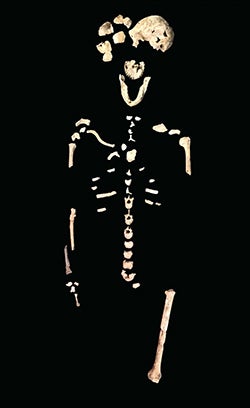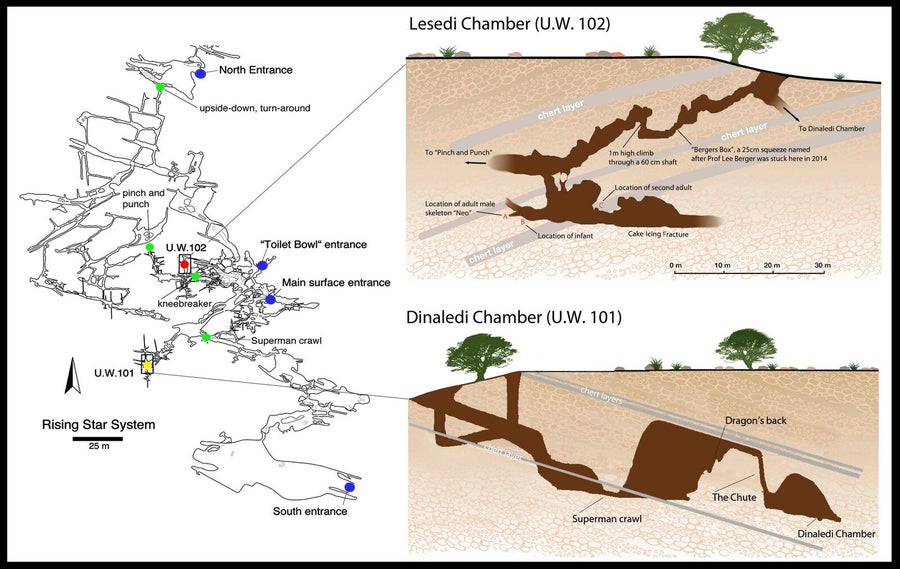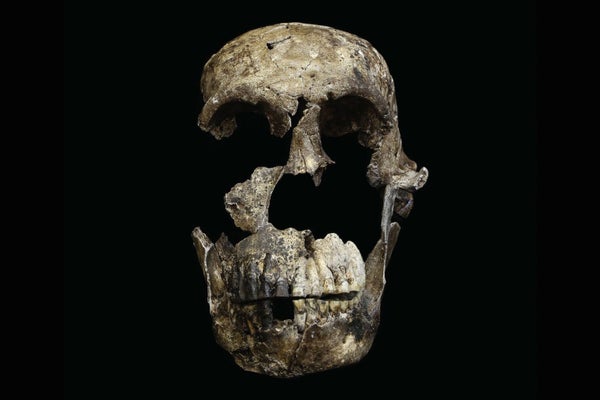In 2015 researchers caused a sensation when they unveiled more than 1,500 human fossils representing some 15 individuals, male and female, young and old, discovered in South Africa. It was an almost unimaginable bonanza, one of the richest assemblages of human fossils ever found, recovered from a chamber deep inside an underground cave system near Johannesburg called Rising Star. From it, the team was able to deduce the bones belonged to a new species, Homo naledi, which had a curious mix of primitive traits, such as a tiny brain, and modern features, including long legs. They determined it was a capable climber, a long-distance walker, a probable toolmaker. And they suggested this peculiar cousin of ours might have taken great pains to dispose of its dead in the pitch-dark, hard to reach recesses of Rising Star.
Yet for all that the team was able to glean from the bones, the discovery is perhaps best known for what the researchers could not ascertain: its age. The creature’s primitive characteristics suggested it was old, perhaps hailing from a time close to when our genus, Homo, originated, more than two million years ago. But its modern traits, along with the condition of the bones, which seemed to be only barely fossilized, hinted that H. naledi lived more recently. Depending on the age, the bones would have different implications for understanding how Homo evolved.
Now that long-awaited piece of the puzzle has finally fallen into place. In a paper published today in eLife, the team reports it has dated the remains of H. naledi. And their age, it turns out, is decidedly young. The researchers also announced the discovery of yet more fossils of H. naledi in a second chamber in Rising Star. The findings raise intriguing questions about the origin and evolution of Homo.
On supporting science journalism
If you're enjoying this article, consider supporting our award-winning journalism by subscribing. By purchasing a subscription you are helping to ensure the future of impactful stories about the discoveries and ideas shaping our world today.
Researchers led by Paul H.G.M. Dirks of James Cook University in Australia determined the age of the original remains using a combination of techniques. Importantly, they were able to date the H. naledi fossils themselves, as opposed to just associated materials, subjecting three teeth to electron spin resonance (ESR) dating, which looks at the electrons trapped in tooth enamel, and uranium–thorium dating, which measures the radioactive decay of uranium. Those results, along with dates obtained for the surrounding rock and sediments, indicate the bones from the Dinaledi Chamber that yielded the original fossil haul are between 236,000 and 335,000 years old. The team had several labs independently date the same samples without knowing one another’s results to help ensure accuracy.

Skeleton of H. naledi individual dubbed “Neo” is one of the most complete early human fossils ever found. Credit: John Hawks Wits University
In a second paper, also published in eLife, John Hawks of the University of Wisconsin–Madison, Marina Elliott of the University of the Witwatersrand in Johannesburg and their colleagues describe 131 new H. naledi specimens representing at least three individuals from another part of the cave system, the Lesedi Chamber, located about 100 meters from the Dinaledi Chamber. Most of the bones belong to an adult male, nicknamed Neo, which means “gift” in the local Sesotho language. With the better part of a skull as well as bones from most other regions of the body preserved, Neo is one of the most complete fossil human skeletons on record. And he exhibits the same distinctive traits seen in the much more fragmentary Dinaledi remains, although his skull housed a brain with a volume of around 610 cubic centimeters—9 percent larger than the brain size estimates for the previously discovered Dinaledi fossils but still much smaller than the average modern human brain size of around 1,400 cubic centimeters. The researchers have yet to date the new fossils. They note, however, that the strong similarities between the Dinaledi and Lesedi specimens suggest they represent individuals from the same population.
Armed with these new findings, Hawks, project leader Lee Berger of the University of the Witwatersrand and their collaborators are raising their bets on controversial claims they made on the basis of the first set of H. naledi fossils. Despite the young age of the bones from the Dinaledi Chamber, the scientists maintain H. naledi’s primitive features link it to much earlier members of the human family. H. naledi may have emerged at around the same time as H. erectus and other early Homo species, they say, or even given rise to H. erectus or H. sapiens. In these scenarios the Rising Star fossils would simply represent a more recent chapter of the long history of H. naledi.
If the researchers are right, southern Africa may have played a more prominent role in the evolution of the lineage leading to us than most experts have envisioned. Received paleoanthropological wisdom holds that east Africa was the hub of human evolution and southern Africa was on the sidelines. But Berger has long pushed the idea that southern Africa might have played a more central role in the forging of Homo. In this latest effort to advance that notion he and his co-authors marshal evidence from other animals to make the case that subequatorial Africa was the center of the evolutionary action.
In addition to shaking up the family tree and the biogeography of human evolution, Berger and his team are taking on enduring ideas about the behavior and cognitive abilities of seemingly primitive human species. They contend the discovery of more bones in another difficult to access part of the cave system supports their hypothesis that H. naledi deliberately placed its dead in these locales. Such mortuary behavior was thought to be exclusive to large-brained H. sapiens. The researchers also note the new dates for H. naledi indicate it lived at a time when human ancestors were making sophisticated stone tools in the Middle Stone Age tradition. Many of the sites where archaeologists have discovered these tools do not contain any human fossils. Experts have typically assumed that large-brained humans made the implements. But if H. naledi was around at that time, Berger and his co-authors suggest, it cannot be excluded as a toolmaker. To date, the team has not recovered any stone tools in association with H. naledi, however.

Click to enlarge. The new H. naledi fossils come from the recently discovered Lesedi Chamber, which is located about 100 meters from the Dinaledi Chamber that yielded the first set of H. naledi bones. Both chambers are extremely difficult to access, leading researchers to propose that this small-brained human species cached its dead in these remote locales. Credit: Marina Elliott Wits University
Experts not involved in the new work say the discoveries are exciting, but expressed some doubts about the team’s interpretations such as the suggestion southern Africa was the hotbed of evolutionary diversification for many mammals, including humans. “Mammalian species diversity is today higher in east Africa than it is in southern Africa,” says paleoecologist J. Tyler Faith of the University of Queensland in Australia. “And much of the evidence that they discuss—particularly points concerning the geographic and genetic history…of African mammals—is usually interpreted as indicating that east Africa is a cradle for diversity and evolutionary innovation whereas southern Africa is analogous to a museum that conserves that diversity through time—not the other way around.” Faith also does not buy the argument H. naledi could have given rise to H. sapiens. “If the dates are correct, then H. naledi is a classic example of an evolutionary dead end,” he asserts, noting the similarities to the miniature human “hobbit” species Homo floresiensis that lived on the Indonesian island of Flores until around 50,000 years ago. “[H. naledi] couldn’t possibly have given rise to living human populations today.”
Nor is it clear the new fossils from the Lesedi Chamber necessarily support the case for mortuary behavior in H. naledi. When Berger’s team formulated that scenario, they based it in part on the fact the Dinaledi Chamber contains only a smattering of tiny animal bones. If the humans had instead fallen into the cave, for example, one would expect to find bones of many more kinds of animals that met a similar fate, including larger ones. Paleoanthropologist Mark Collard of Simon Fraser University in British Columbia observes that the Lesedi chamber contains more fossils of other animals, including some of medium size, which could suggest that H. naledi ended up in there by some means other than intentional disposal.
The team’s suggestion that H. naledi might have made Middle Stone Age tools found in the region has likewise elicited skepticism. Archaeologist Curtis Marean of Arizona State University says the hypothesis is reasonable, but not strong. “If this [species] was a stone tool maker, then it seems almost impossible to me that no stone tools made it into the caves with them,” he comments.
Collard, for his part, gives more credence to the idea. “We’ve had a simplistic understanding of how the archaeological record relates to fossils,” he remarks. “We need to think about the possibility that naledi was involved in the production of one or more of these cultures.” Collard notes that both Neandertals and early H. sapiens made the same kinds of so-called Middle Paleolithic tools in the Near East. Maybe multiple species, including small-brained H. naledi, made Middle Stone Age tools, too. In that case, scientists will need to reconsider the longstanding notion that brain size drives complexity of behavior. Collard thinks there is good reason to do so: “The history of paleoanthropology is littered with deeply rooted assumptions that have been overturned by new discoveries."
